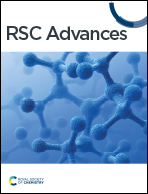Water-soluble fluorescent chemosensor for sorbitol based on a dicationic diboronic receptor. Crystal structure and spectroscopic studies†
Abstract
Selective recognition of saccharides by phenylboronic dyes capable of functioning in aqueous conditions is a central topic of modern supramolecular chemistry that impacts analytical sciences and biological chemistry. Herein, a new dicationic diboronic acid structure 11 was synthesized, structurally described by single-crystal X-ray diffraction, and studied in-depth as fluorescent receptor for six saccharides in pure water at pH = 7.4. This dicationic receptor 11 has been designed particularly to respond to sorbitol and involves two convergent and strongly acidified phenyl boronic acids, with a pKa of 6.6, that operate as binding sites. The addition of sorbitol in the micromolar concentration range to receptor 11 induces strong fluorescence change, but in the presence of fructose, mannitol, glucose, lactose and sucrose, only moderate optical changes are observed. This change in emission is attributed to a static complexation photoinduced electron transfer mechanism as evidenced by lifetime experiments and different spectroscopic tools. The diboronic receptor has a high affinity/selectivity to sorbitol (K = 31 800 M−1) over other saccharides including common interfering species such as mannitol and fructose. The results based on 1H, 11B NMR spectroscopy, high-resolution mass spectrometry and density functional theory calculations, support that sorbitol is efficiently bound to 11 in a 1 : 1 mode involving a chelating diboronate–sorbitol complexation. Since the experimental B⋯B distance (5.3 Å) in 11 is very close to the calculated distance from the DFT-optimized complex with sorbitol, the efficient binding is attributed to strong acidification and preorganization of boronic acids. These results highlight the usefulness of a new diboronic acid receptor with a strong ability for fluorescent recognition of sorbitol in physiological conditions.



 Please wait while we load your content...
Please wait while we load your content...